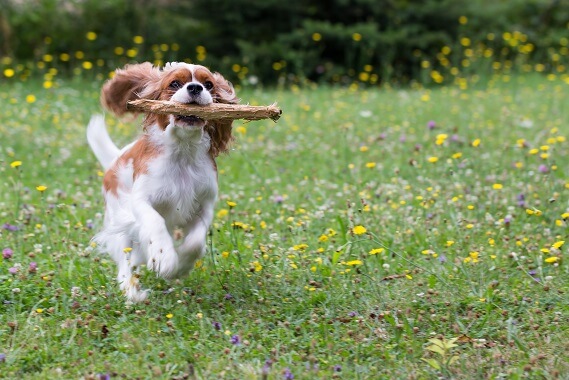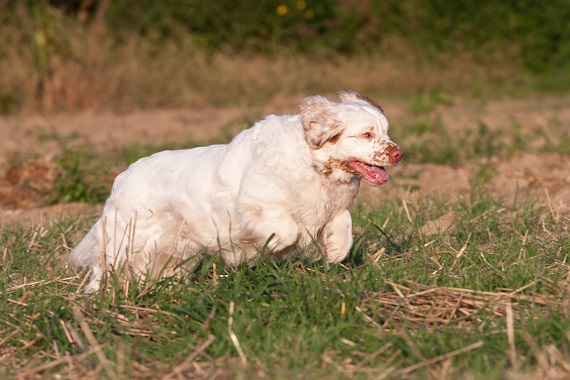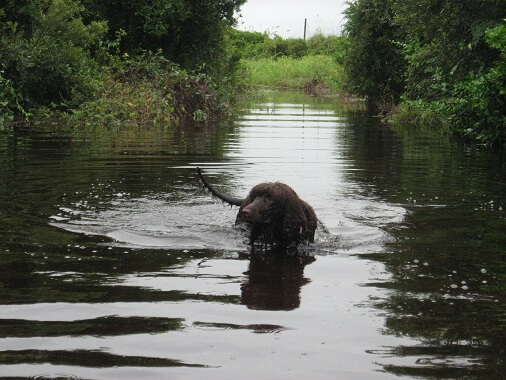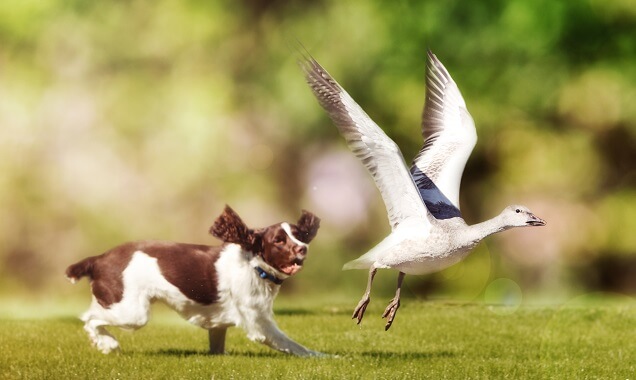
The spaniel is a type of working dog that was first bred to accompany people who hunted game birds. Its job was to chase the birds out of dense vegetation and to retrieve it once it has been shot. While many spaniels are still working dogs, other breeds have been bred as companion dogs and make great family pets. The different breeds have different traits and different jobs and they come in a variety of sizes and colors. Today, the American Kennel Club recognizes 15 different spaniel breeds. Most spaniels are medium-sized dogs and have a rather broad muzzle, long ears, and a wavy, long coat. Some of these spaniels are small in size, weighing just 6 lbs, whereas the largest spaniel, the clumber spaniel, can reach up to 70 or 80 lbs! Spaniels tend to be high energy, athletic, and enthusiastic which is what makes them the perfect companion dog for hunters. They are also highly trainable and eager to please, although specific temperaments vary between the different breeds. Originally bred as working dogs, different types of spaniel have occurred as people selectively bred them for different traits. Land spaniels were bred to work in forests and fields, whereas water spaniels were bred to retrieve waterfowl and are extremely good swimmers. Some spaniels are small and were bred to be companion dogs, mostly due to their loveable nature. Let’s take a look at some of the different spaniel breeds. English springer spaniels have fantastic scenting abilities and love having a job to do. This breed is one of the more active spaniel breeds and won’t do well in a sedentary household. They have a fantastic sense of smell and are popular working dogs. Their sense of smell is so good that springer spaniels are also often used bu the military and the police for bomb and drug detection! These dogs are usually white and black, or white and liver and have a medium-length coat that can be flat or wavy. Medium length fur is also found on their legs and tail. They weigh between 40 and 50 pounds. 2. American Cocker Spaniel American cocker spaniels are smaller and more compact than the English springer spaniel. They come in a wide variety of colors and patterns and have silky smooth, long hair that can be wavy or flat. They weight between 20 and 30 pounds. This spaniel is known for being people orientated and very playful. They are good around children and generally get on with other dogs too. 3. Cavalier King Charles Spaniel Originally bred as companions for the British nobility, these small spaniels are now the most popular spaniel breed in the US. They have an affectionate, happy-go-lucky personality and are less driven than most of the other spaniel breeds. Cavaliers are a part of the toy dog group, weighing just 13 – 18 pounds, and require much less exercise than other types of spaniel. 4. American Water Spaniel The American water spaniel is a midsized gundog that is recognizable by its curly or wavy brown coat. These dogs are native to the lake country in the upper midwest of the US, where they were bred to work in the cold, icy conditions found in the Great lakes region. These dogs are well equipped for working in the water as they have a dense waterproof coat that protects them from the cold, and webbed toes which help them to swim. They are intelligent and versatile, and like English springer spaniels, need to be kept active or they become destructive. 5. Clumber Spaniel The clumber spaniel was developed in the United Kingdom and is the largest of the spaniel breeds. It is a powerful dog with a massive head. They have a white coat which can feature lemon or orange markings. Clumber spaniels have a sweet and easygoing nature and are eager to please. These intelligent dogs respond well to training. Clumbers enjoy swimming and fetching. The largest clumber spaniel can reach 85 pounds! Spaniels are high energy and happy dogs that were originally bred as hunting companions but are now quite often selected as loving family pets. Several aspects of their biology make them great gun dogs, while other aspects of their personality are prized characteristics in therapy dogs. Let’s take a closer look. Springer spaniels and cocker spaniels are some of the oldest gun dogs. They are thought to have the same origin and used to be the same breed. When a litter of puppies was born it would be separated by size with the smaller dogs being designated as Cocker spaniels and the larger dogs were designated as Springer spaniels. The smaller dogs were trained to hunt a bird called the woodcock whereas springers were trained to hunt larger game. It wasn’t until the early 1900s that these two dogs were recognized as separate breeds. English springer spaniels and English cocker spaniels are two of the best dogs to use as a hunting companion. One thing that these dogs are good at is finding game birds and flushing them out of thick vegetation so that they can be shot by the hunter. The dogs are trained to recognize the scent of a bird, go out into the field and flush it out of hiding before bringing the downed bird back to its master. It can take several years of training before the dogs have perfected their skills. They must learn to point the birds, or chase them in a certain direction so that they take flight. They must also learn to bring the birds back to their master undamaged. Spaniels have a good sense of smell and concentrate hard on a scent when they pick it up, making them perfect flushing dogs. Spaniels are intelligent dogs that have an affectionate and loving nature and because of this, they have often been used as therapy dogs. The idea of an official therapy dog first came about during World War 1. An officer’s dog was allowed to stay with him in the hospital ward and it bought cheer and happiness not only to him but also to other people in the ward. Spaniels are good therapy dog candidates as they are highly intelligent so they can be easily trained. They are also very social and happy to be around people. Dogs are good candidates for use as companion and therapy dogs because they appear to provide comfort and recognize human emotions. To understand this further, several studies have been done to assess if dogs can recognize human emotion. Research suggests that dogs can feel empathy and recognize positive and negative emotions. They also try to comfort people in distress.
Kingdom
Animalia
Phylum
Chordata
Class
Mammalia
Order
Carnivora
Family
Canidae
Genus
Canis
Species
Canis lupus
Subspecies
Canis lupus familiaris
Height
Dependant on breed, ranging from 8 – 20 inches
Weight
Dependant on breed, ranging from 6 – 70 lbs
Lifespan
12+ years
Social Structure
Domesticated, gun dogs, companion dogs
Status
Least concern
Natural Habitat
Domesticated
Average Litter Size
Varies
Main food item
Dog food
Potential predators
Few predators
The Basics

Different Spaniel Breeds

Fun Facts about the Spaniel!
The Same Breed
Flushing

Therapy Dogs
